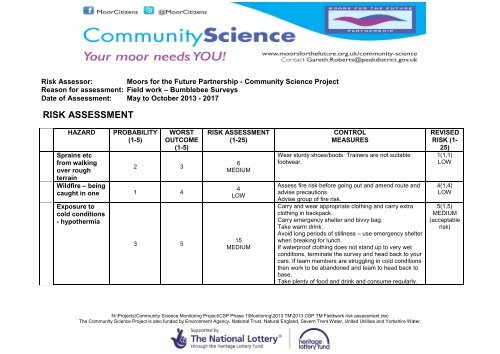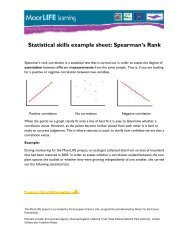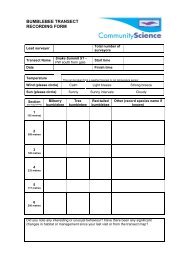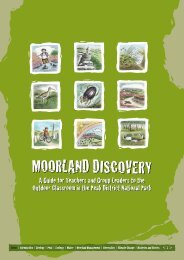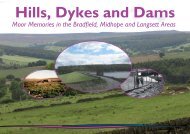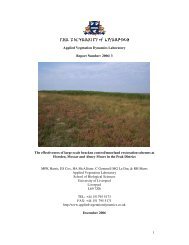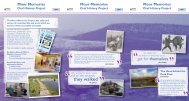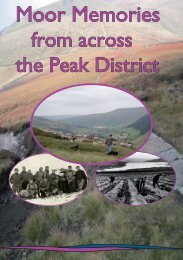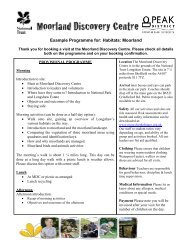RISK ASSESSMENT - Moors for the Future
RISK ASSESSMENT - Moors for the Future
RISK ASSESSMENT - Moors for the Future
You also want an ePaper? Increase the reach of your titles
YUMPU automatically turns print PDFs into web optimized ePapers that Google loves.
Bites andStings 1 1Accidentalimmersion in<strong>the</strong> water,ei<strong>the</strong>r partial ortotal.3 2Health risksfrom contactwith aquaticenvironment,2 3e.g. Tetanus,Weils disease.Trip hazards,on <strong>the</strong> bank. 3 1Fast movingtraffic on mainroads2 41LOW6MEDIUM6MEDIUM3LOW8MEDIUMAdvise use of insect repellents.Wear long sleeved tops and trousers.Do not trap / handle bumblebeesDo not handle o<strong>the</strong>r insects, animals, birds or reptiles.Do not survey / work alone.Carry emergency blanket and warm drinks.Carry and mobile telephone And radio if available).Cover all wounds with a waterproof dressing.Wash hands be<strong>for</strong>e touching eyes, face, mouth, oreating.Take care on <strong>the</strong> bank.Wear suitable footwearExplain hazards to groups/individuals1 (1,1)LOW3 (3,1)LOW3 (1,3)LOW2 (2,1)LOWPark safely 4(1,4)Probability:Worst Outcome:1. Highly Improbable 1. Minor Injury2. Less Than Even Chance 2. 3 Day Injury3. Even Chance 3. Incapacity/ Amputation4. Probable 4. Fatality5. Almost Certain 5. Multiple FatalityN:\Projects\Community Science Monitoring Project\CSP Phase 1\Monitoring\2013 TM\2013 CSP TM Fieldwork risk assessment.docThe Community Science Project is also funded by Environment Agency, National Trust, Natural England, Severn Trent Water, United Utilities and Yorkshire Water.
Reviewed by: Gareth Roberts July 2013Checked by:General GuidanceNotes on risk assessment and completion of this <strong>for</strong>mNotes/in<strong>for</strong>mation:Signs of Hypo<strong>the</strong>rmia: Mild hypo<strong>the</strong>rmia:Bouts of shiveringGrogginess and muddled thinking. Moderate hypo<strong>the</strong>rmia:Violent shivering or shivering which suddenly stops;Inability to think and pay attention;Slow, shallow breathing;Slow, weak pulse. Severe hypo<strong>the</strong>rmia:Shivering stops;The patient loses consciousness;There is little or no breathing;Pulse is weak, irregular or non-existent.Personal Kit – each person is to ensure <strong>the</strong>y have <strong>the</strong> following: 30-75 Litre RucksacksN:\Projects\Community Science Monitoring Project\CSP Phase 1\Monitoring\2013 TM\2013 CSP TM Fieldwork risk assessment.docThe Community Science Project is also funded by Environment Agency, National Trust, Natural England, Severn Trent Water, United Utilities and Yorkshire Water.
Survival Bag Waterproof Jacket Waterproof Trousers Warm clothing – a matter of personal preference but your equipment must be suitable <strong>for</strong> spending 7-8 hours above 500m altitude onexposed ground in winter conditions. 3-4 Season Walking Boots, with ankle support, waterproofing Winter walking socks Spare socks Hat – <strong>for</strong> warmth and protection from strong sunlight Water proof / windproof / insulated gloves Head Torch + spare batteries Map – OL1 Dark Peak Compass Whistle Personal First Aid Kit Food and Drink (enough <strong>for</strong> personal needs <strong>for</strong> 1 day on <strong>the</strong> hill) Additional emergency rationsPlease ensure that ALL members of your group have read and understood this risk assessment.Please ensure that you have a copy of this risk assessment with you at all times during <strong>the</strong> survey.N:\Projects\Community Science Monitoring Project\CSP Phase 1\Monitoring\2013 TM\2013 CSP TM Fieldwork risk assessment.docThe Community Science Project is also funded by Environment Agency, National Trust, Natural England, Severn Trent Water, United Utilities and Yorkshire Water.


